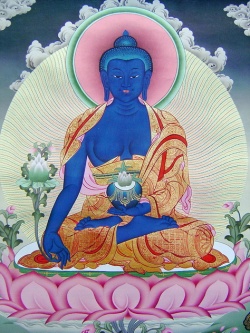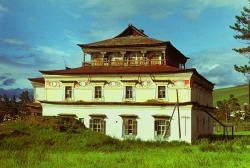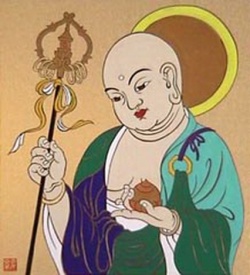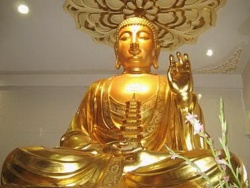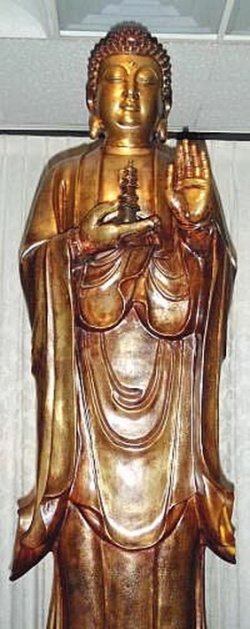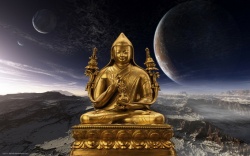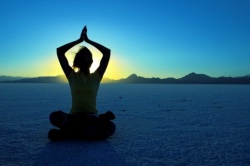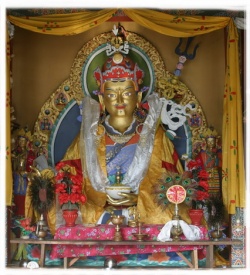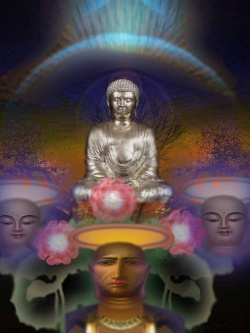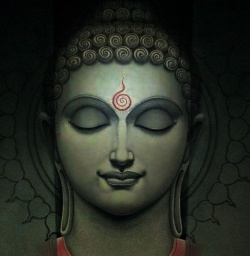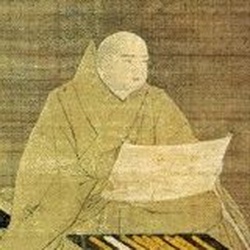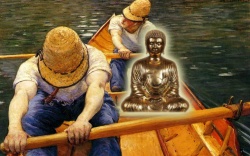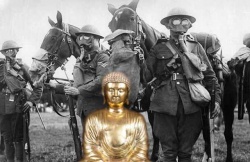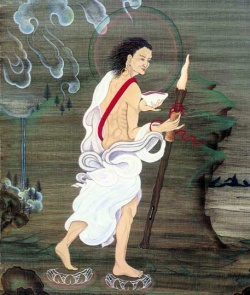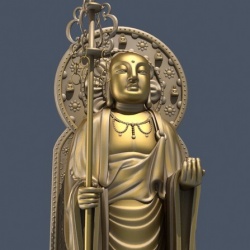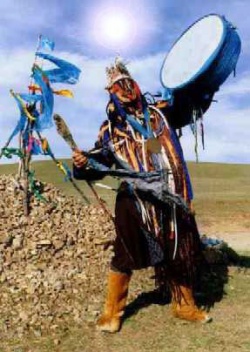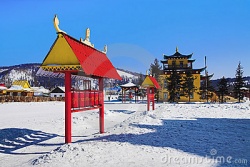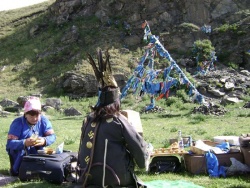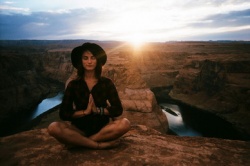Medical Illustrations of the Atsagat Manba Datsan by Dr. Natalia Bolsokhoeva
In September, 2011 at the conference in Tallinn I talked about a contribution of eminent traditional Tibetan doctor, a remarkable scholar in the field of Tibetan science of healing D. Yendonov (1870 -1937?) to the composition of the textbook, guidance, dictionary and his life.
His works played the most important role in the educational process at the well-known Atsagat manba datshang.
In 1913 this medical school was established on the initiative of the great Buryat authorities Agvan Dorzhiev (1853/54 - 1938) and Khampo Lama (since 1895 г. until 1911 г.) and the most outstanding Buryat an emchi - lama Ch. - D. Yiroltuyev (1843 - 1918).
Activities of medical school inseparably linked with the Atsagat Tubten Dargya Ling (thub bstan dar rgya gling) or the Shuluut datsan.
It was built on the river side Shuluuta close to the spur of the mountains Sagaan Under in 1825. D. Yendonov was the director of this prestigious [[Atsagat medical college}} since 1926 until its closing in 1936.
In addition D. Yendonov made a great contribution to the composing the visual aids on Tibetan medicine for the Buryat emchis and medical students.
He was an initiator, author and leader of the project on the creation of medical paintings by Buryat artists, physicians and medical students.
Besides he formed a creative group for making copy of the plates of the since 1926 kept at the Atsagat manba datsan.
Upon the request of Agvan Dorzhiev set of the “Atlas of Tibetan medicine” was transferred from the Tsugol datsan Tashi choiphel ling (Chita region) to .the Atsagat medical faculty.
Our many years research proofed that there is reason to considerate the separated plates in a varying degree as rough copies of the “Atlas of Tibetan medicine”, as on the several plates the remarks were made”, a copy of the drawings of the “Atlas of Tibetan medicine”.
In this connection we began a complicated work on the identification of the contents of the Atsagat illustrations with corresponding visual ranges on the canvas of the “Atlas of Tibetan medicine” from the History Museum of Buryatia named after M. N. Khangalov collection (further Museum).
In the valuable collection of the Museum there are 65 plates of different formats of medical contain with a separated chapters on Tibetan medicine depicting by director and students of the Atsagat medical faculty.
They painted on separate album sheets, on whatman paper and primed canvas.
They represented an illustrated material, subordinated mainly to the subject and structure of some paragraphs, chapters, and volumes of classical Tibetan medical treatise “Gyushi” (rgyud bzhi) and its comprehensive commentary ‘Lapis Lazuli’ (vaidurya sngon po, Vaidurya - onbo).
In the Atsagat set there is a plate, showing the mandala of the Supreme Healer - the Buddha of Medicine (Sanskrit: Bhaishajyaguru, Tib. sangs rgya sman bla).
The Healing Buddha gives teaching to a retinue of gods, sages, Hindu divinities and Buddhist disciples.
There is some analogy with the first plate of the “Atlas of Tibetan medicine”.
The Healing Buddha is depicted in the medicinal city Sudarshana (Tib. lta na sdug) with the attributes of the Buddha sitting up on a throne made of wish-fulfilling jewels. In the center of the square city with four gates is located the Medicine Buddha’s palace.
In the center of this palace sits the Healing Buddha, Buddha of Byrel colour in an intensive blue color, color of lapis lazuli.
A begging bowl filled with the nectar of immortality is in his left hand.
His right hand holds the myrobalan chebula fruit (Tib. a ru ra, Latin Terminalia chebula Retz.), panacea for all diseases caused by disorder of three physiological energies (Sanskrit dosha Tib. rlung - wind, mkhris pa - bile and bad-kan - phlegm).
Mandala is distinguished from a classical one depicted in the “Atlas of Tibetan Medicine” by its amazing simplicity.
There are no depictions of his retinue of gods, sages, Hindu divinities and Buddhist disciples listening to the teaching of Tibetan science of healing (gso ba rig pa).
Each representative understood and interpreted teaching of the Medicine Buddha Bhaishajyaguru according to his knowledge.
We don’t see the images of mountains where the curative plants and herbs grow, no animal, mineral raw materials, and healing springs.
In the Atsagat version some of kinds of raw materials are painted on four parts of world.
In peculiar manner the Maharajas are depicted. They protect four parts of the world from enemies of Dharma (Teaching).
The medical pictures of Buryat specialists are distinguished by their peculiarities and are reflected a definite stage of scientific illustration in the creative activity of Buryat artists possessing by the art of easel painting. The authorship of some plates is belonged to D. Yendonov as it is mentioned: “The director Yendonov painted”.
On a number of plates there are no names just “The student’s work of khuvarak (novice) of the Atsagat medical school”.
On the plates there are no author’s numerations, from my point of view they could be distinguished by sizes 53х35, 43х20, 22х20, 29,5х34, 43х22.
On the back side there are the stamps of the Buryat - Mongolian Antireligious Museum (opened on the 8th of November of 1937 in Ulan-Ude), its address and obviously the incoming number assigned by the Museum.
In the contemporary Museum’s inventory books the plates are sequentially numbered from 1 to 65. On the facial sides of the mostly all 65 plates there is a big round seal of Atsagat Tibetan Medical Committee and signature of director Yendonov.
This fact says that the student’s creations were appreciated by the director of the school. He knew a professional level of each student and carried the high responsibility to the theoretical and practical knowledge, which the students received under the guidance of the knowledgeable teachers during a long-term training.
Student’s works in a remarkable degree connect with the practical chapters of Tibetan science of healing, which are necessary to know for the future professional traditional doctors in their daily practice.
Many anatomical plates contain the drawings of topography of internal organs on modular grid where each square cell is a module of measurement.
The pictures of anatomical plates are given with precise indications of each organ and its separated organs that it is extremely need for making treatment in depending on the kind of the illness.
These treatments include cauterization, bloodletting, pricking by needle.
The latter is to some degree similar to an acupuncture that widely spread in Chinese medical tradition and found recognition throughout the world.
On the anatomical plates the points for thermal treatments in the forms of cauterization a warming up are pictured as the most effective treatment methods for many illnesses including serious chronic ones.
The total amount of the points is 71; 20 points are located on the back side of the body, 22 – on the front side, 29 – on the head and extremities.
In addition, the plates illustrate the bloodletting vessels and points of pricking by the needle.
Almost all bloodletting vessels are paired, they are symmetrically located on the right and left sides of the head, right and left hands, right and left sides of the body.
Our deep study show, on the plates there are three unpaired vessels fontanel, nose’s vessel, breast’s vessel, and bloodletting vessels varying from the kind of pathology.
Acupuncture is an important method of the treatment of the exterior and interior solid tumors, solid tumors of kidneys, spleen and stomach.
Some treatments are held by hot / red-hot needle, while the other by cold-needle.
It should be noted that the points of cauterization and warming-up are of red color, the points of acupuncture are yellow, and the points of bloodletting are blue.
Such color principals are traditional and used in the “Atlas of Tibetan Medicine” that has been to a remarkable degree a prototype for illustrations of D. Yendonov and his talented pupils.
Based on our investigation we can conclude that the plates as a rule have the titles; an anatomical human figure is in the center and fitted with short or detailed annotations.
They are written in Tibetan language or in Tibetan with an old Mongolian translation or only in old Mongolian.
The annotations and captions under drawings lacked the unification that is a short - coming of the work. Most often the images of man’s figures are not proportional and have a contour character.
Medical paintings were used not only as the visual aids in the educational process or aims; the students have passed the exams on them.
In the Tibetan medical texts is said, a disciple was sitting in front of the teacher and was talking about the contents and meanings of every picture in illustrated range on the plates.
In addition the student was asked to indicate the illustration of the one or other plate correctly related with the chapter of four volumes of the Root text “Gyushi”.
Such approach served as a good orientation for the teacher to determine the level acquired knowledge during a long term of studying .
It was considered that this part of the exam was the most difficult as the student must demonstrate the volume of an acquired knowledge on all course on Tibetan healing science.
The images of surgical instruments used in practical Tibetan medicine are the important component of the anatomical plates. Presented illustrations in the corpus of the Atsagat paintings say that Buryat physicians have not much ones.
On the Atsagat plate only 43 instruments painted. While in the plate 34 of the “Atlas of Tibetan Medicine” there are 99 surgical instruments which were used by traditional doctors (emchis) throughout Tibet.
The illustrations testify that in the medieval centuries the Tibetan medicine had a definite instrumental arsenal each of them had the specific meaning and was widely used into surgical operations.
In the “Vaidurya - onbo”, a commentary on the Tibetan medical culture “Gyushi” there is an classification of surgical instruments into five groups:
1 – the instruments for the survey,
2 - forceps,
3 – lancets,
4- thur ma or needles and
5 – auxiliary instruments.
The characteristics and a detailed description of the instruments are given in the twenty second chapter of “Tantra of Explanation” of the second volume of “Gyushi” and in its profound commentary “Vaidurya - onbo”. Such classification is accepted in the plate 34 of the set of the “Atlas of Tibetan Medicine” as well.
Buryat emchis in difference from their Tibetan predecessors used the probes for the checking up the wounds on legs and arms, the probes for the investigation of the purulent abscesses: forceps for the extraction foreign bodies from bones, blood vessels, tendons.
Peculiar lancets were needed for bloodletting; hollow needles for the extraction of pus and liquids from the certain parts of the body, the bent hooks for the deleting of the pellicle of eyes if a person suffer from wall-eye, and the bent rods for cauterization.
Each Buryat healer carried the needed surgical instruments with him in a special slipcase.
Buryats historically differ by a proficiency and high technique of the iron processing and only special trained masters produced the medical instruments that had certain initiations.
It is happened that the instruments needed for practice were been made by skilled emchi-lamas themselves. Most often this art was transferred from generation to generation.
Instruments were made from the alloy of red cooper and gold, and a durable high quality steel as well.
At the same time in Tibet they were made from expensive metals: gold, silver, a durable and special processing steel and finest iron.
Buryat skilled masters as their Tibetan colleagues made the instruments strictly according to the sizes presented in Tibetan practical guidance’s. The sizes come from particular canon that each master must follow.
Some samples of the medical instruments that were used by Buryat healers in their medical practice presented in the Museum’s collection.
Some of them were exhibited at the exhibition, which was opened on August 10th of 1998 and worked during one year at the Museum in Ulan-Ude.
Those medical instruments give a little information on the instrumental arsenal in the practice of professional Buryat emchi-lamas.
Tree of Medicine
The paintings presenting the “Tree of Medicine” constitute the second group.
The scheme of the “Tree of Medicine” may be considered as the alternative of “the Universal Tree” – “Scambha”, translated from Sanskrit as “reliance”. “Scambha” symbolizes sustainable links between past and future, the world of gods and human beings.
The ancient Indians were aware about the idea of “the Universal Tree” from the “Book of Exorcism” (Atharvaveda), dated the first century before BC.
It is part of the corpus “The Four Vedas” and it is considered as the first ancient Indian text closely linked with medical knowledge.
The illustrations of the “Tree of Medicine” include the depictions of the healthy and ill organism, the causes of the diseases, balance and imbalance of three physiological energies'
They only define all the functions of the human beings’ organism and relatively are identified with the principals of movement, fire and softening.
Only the restoration of the system integrity let reach the recovery of the patient.
It is important to know that Tibetan medicine doesn’t treat the symptoms of the illness; it aims to eliminate the causes of the imbalance, the restoration of the natural resources of organism.
In addition hence following methods of diagnoses are indicated: survey, pulse examination, analyses of urine, questioning of the patient and also the methods of treatment.
The illustrated structural elements of the “Tree of Medicine” represented a detailed schematic description of theory and practice of Tibetan medical system in the form of the three trees with 9 trunks, 47 branches and 224 leaves.
The third group includes the plates with images of the spirits and demons affecting negatively on a person and in this connection causing certain diseases.
Based on the “Gyushi” we can say that half of the illnesses known to the Tibetan physicians were attributed to the effect of harmful deities and spirits, as karmic punishment violating various taboos and rules of religious morality.
“For the medieval doctor, divination was one method of diagnosis, a way to determine the causes of an sickness.
It was important to establish precisely which demonic forces were harming the patient’s health in order to eliminate their injurious influence by means of rituals of propitiation, elimination and suppression”
Only three plates are belonged to the forth group.
Two of them are reasonable to classify as a kind of abstracts of the students of the Atsagat manba datsan representing the theses of a number of the chapters, paragraphs, fragments from educational supplies on the all course of Tibetan medical science.
The notes are written in old Mongolian by black ink of European production in clear calligraphic manner.
The most probably that the khuvaraks (novices) owning the art of calligraphy have written these abstract’s texts
From my point of view it is also reasonable to relate the rules on compliance with sanitary standards to the forth group as they are not fitted to the illustrative material.
The rules working out by D. Yendonov is written in old Mongolian. The traditional Tibetan physician has recommended keeping strictly the rules for taking curative baths and pharmacy’s work, when specialists involve in the composition and preparation of multi - component Tibetan drugs.
These rules were concerned not only to the students of Atsagat medical school, but to the people, who used to come to get the healing springs. Each person must keep strictly to the established order and keep clean the sacred territory.
The Yendonov’s rules did not lose its actuality in the globalization’s époque. The contemporary lamas of the Atsagat datsan do much not only for conservation of the curative springs but the maintenance of needed rules. They take care of this powerful area and give instruction to young generation.
It seems strange that in the corpus of Atsagat illustrations there is no the plates with the medicinal materials of flora, fauna and mineral origins.
It is obviously the students took part in annual expeditions and they studied the medicinal raw materials in natural environment under the guidance of supervisors.
More over, all over the Atsagat territory and nearby there is the variety of medicinal plants and herbs.
The Atsagat region could be compared with the Yarlung valley in Tibet, where from point of view of Tibetan emchis a great number of curative plants and herbs grow up.
Due to their high effectives they use by skilled traditional doctors of many generations in their successful medical practice.
Besides the works of khuvaraks of the Atsagat medical school in the Museum’s collection there is a set of 11 one formatted (62х69,4 cm) plates depicted by Buryat artists with mineral colors on the primed canvas.
On the back side at the bottom of each plate there is a stamp of the Buryat - Mongolian Antireligious Museum.
The talented Buryat artists (zurachiny) have owned the technology of canvas preparing and techniques of the drawing on the canvas.
A complicated technique of primed canvas was borrowed not only from written sources, but from Tibetan and Mongol teachers and colleagues.
Not excluded that some Buryats have studied under the supervising of outstanding Tibetan and Mongol experts.
The technique of the preparing of primed canvas consists of the following: “an artist makes a weak solution of glue for the front side of canvas for not to let the paint soak into tissue as the picture must be intensive on colors.
Then the artist made several layers of ground – glue mixed with chalk, gypsum or kaolin.
When the priming was dried up and ready, it was polished for the smooth solid and flexible for the keeping up the layer of colors. Sometimes they made a primed canvas not only on the front side but the back side also”.
It should be mentioned; this method of the preparing primed canvas for the drawing was considered to be traditional and widely spread in many regions of the [[Wikipedia:Central Asia|Central Asia]].
Nowadays it is used by the modern artists that I observed during my study trips to India, Nepal, Bhutan and Tibet.
The paintings are distinguished by interesting technique and manner that reflect a certain stage in the creation of Buryat artists owning the art of the easel paintings.
Proceeding from the inscriptions on the certain plates it may conclude that they were created between of 1929-1930. However historical sources provide no one opinion about the appearance of the set, consisting of 65 plates.
It is difficult to say when the plates were given to the Museum’s collection as we don’t have any information.
There are no the living witnesses who could give reliable facts about it.
Possibly, the Atsagat paintings entered the Antireligious Museum’s collection in 1937 when Zh.Zh. Zhabon (1899-1971) was working as a member of the Republican Organization of the Society of the Militant Godless and transferred to the possession to the Museum the treasure of the Tibetan medieval culture the “Atlas of Tibetan Medicine”.
He was the chief curator of the valuable collection of Buddhist Art of the History Museum of Buryatia named after M.N. Khangalov since 1952 until 1970.
CONCLUSION
In June of 2004 the Atsagat datsan that has been restored in 1992 and the public of Buryatia at large have celebrated 150 anniversary of the outstanding Buryat personality Agvan Dorzhiev.
In this connection according to the information of the Museum’s staff S.V. Bardaleyeva the Xerox copies of 20 plates in original size which have been painted by the students of the Atsagat medical school were given to the datsan.
Now they are kept at the collection of the Atsagat Museum within the Buddhist monastery.
The finest work on framing the plates under the glass was held by the artist V.P. Askhayev.
The depictions of the Atsagat medical school, painted at the thirties of last century have now an elegant appearance. During the last several years the Museum step by step has been passed the copies of other 45 plates.
It is important that the illustrations became again visual aids for the pupils studying a complicated subject of Tibetan medical culture under the guidance of highly - qualified Buryat teachers.
The medical drawings of the Atsagat medical faculty completed under the leadership of D. Yendonov are becoming a heritage of the peoples.
It should be noticed that nine plates from the set, consisting 65 plates are demonstrated in the permanent exhibition of the History Museum of Buryatia named after M. N. Khangalov.
Thanks to the Museum’s staff the inhabitants of the Buryat capital and its guests have a great possibility to make aware with the drawings of Tibetan medical culture created by Buryat skilled masters and traditional physicians.
The plates represented in the exhibition are in the nice wood frames making them an organic part of the conception of exhibition.
The Atsagat depictions are distinguished by particular style, a technique of images and colors reflect a definite level of Buryat spiritual culture in the thirties years of last century.
The 11 paintings from the set, consisting of the 65 plates were published in the book, entitled “The Atlas of Tibetan Medicine in the cultural space of [[Wikipedia:Central Asia|Central Asia]]”, the authors V. Shaglakhaev ([[Dashi Lama) and N. Bolsokhoeva. Ulan-Ude. 2010. Those drawings give valuable materials for the profound study the principles and features’ of the illustration in Transbaikalia..
REFERENCES
Primary sources
- Bris cha (“The Atlas of Tibetan Medicine”), consisting of 76 plates. The History Museum of Buryatia named after M.N. Khangalov. Ulan-Ude: Inv. No. 15. A. 18-79. Sizes of the plates 65x88.
- Bris cha (Illustrations on Tibetan Medicine of the Atsagat Medical School). The History Museum of Buryatia, named after M.N. Khangalov. Ulan-Ude: OF 8281.
- Tenzin Phuntsog Shel ‘phren. Aginsk Edition, the end of the XIX c. 223 f.
- Yendonov D. Textbook on anatomy and physiology, manuscript. The History Museum of Buryatia, named after M.N. Khangalov. Ulan-Ude: OF14824 (12) (in old- Mongolian).
- Yendonov D. Russian-Mongolian Dictionary of medical terminology. The History Museum of Buryatia, named after M.N. Khangalov. Ulan-Ude: OF 18405.
Secondary sources
- «Атлас тибетской медицины». Свод иллюстраций к тибетскому медицинскому трактату XVII века «Голубой берилл». 1994. Вступительные статьи Н.Д. Болсохоевой, Д.Б. Дашиева, В.С. Дылыковой - Парфионович, К.М. Герасимовой, Л.Э. Мялля, Т.В. Сергеевой. Перевод текста атласа Т.А. Асеевой, Н.Д. Болсохоевой, Т.Г. Бухашеевой, Д.Б. Дашиева. Пояснительный текст к листам атласа составил на основании исследования тибетских медицинских трактатов «Четверокнижие» и «Голубой берилл» Ю.М. Парфионович, из-во «Галарт», М.,592 c..
- Bolsokhoeva N.D. 1992, the Mandala of the Medicine Buddha-Menla. According to the “Atlas of Tibetan Medicine’ in. Buddhist Himalayas. Kathmandu, 5, No. 1&2:
- Bolsokhoeva N.D., Gerasimova K.M. 1998, the “Atlas of Tibetan Medicine”. Treasure from the History Museum of Buryatia in ‘The Buddha’s Art of Healing. Tibetan Painting Rediscovered. Foreword by His Holiness of the Dalai-Lama XIV. New York: Rizzoli, 33-60.
- Bolsokhoeva N.D, 2007. Tibetan Medical Illustrations from the History Museum of Buryatia, Ulan-Ude in Asian Medicine. Tradition and Modernity. Leiden. Brill Academic Publishers, vol. 3, No. 2. 347-367.
- Shaglakhaev V.A. (Dashi Lama), Bolsokhoeva N.D, 2010. ‘The Atlas of Tibetan Medicine’ in the cultural space of Central Asia. Publishing - House of the Republican Centre of Medical Prophylaxis of Ministry of Public Health of Republic of Buryatia. Ulan-Ude. 86 p. (in Russian).
Source
Author: Dr. Natalia Bolsokhoeva
buddhismandaustralia.com
